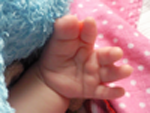Syndactyly
Description
Syndactyly refers to joined or "webbed" digits - in the hand, most often this refers to adjacent fingers which are grown together. Syndactyly is one of the most common variations on the basic growth pattern of the hand.
There are many different forms of syndactyly.

• When the fingers are completely joined together, it is called "complete" syndactyly.
• When the join involves only part of the sides of the fingers, it is referred to as "incomplete" syndactyly.
• If the join between the fingers just involves the skin and flesh, it is described as "simple" (although it certainly isn't).
• If the bones are joined together, it is called "complex" syndactyly.
Cause
Syndactyly occurs in the womb as a detour on the road to developing one thumb and four separate fingers on the hand. In the womb, the new hand starts out in the shape of a paddle, then splits into separate fingers. Sometimes the fingers don't split apart enough, and webbed fingers result: syndactyly. Sometimes a extra split forms and extra fingers result: polydactyly.
Syndactyly and polydactyly are about equally common disorders. Combinations of both can occur as well - webbed extra fingers. Why does a child have this? It is not due to anything the mother did during pregnancy - it just happens. Sometimes these problems are in the genes and can be passed down generation to generation, but many times there is simply no known explanation.
Treatment
The main decision is to decide whether or not to do anything for the problem. Certain types of syndactyly are associated with other birth related problems elsewhere in the body, and it is a good idea to have an evaluation for this reason alone. Surgery for syndactyly is usually best done in the first few years of life so that the look, feel and function of the corrected hand is the most natural for the child.
A hand therapist can help with some problems before and after surgery, tailored to the individual problem and the temperament of the child. After surgery to separate fingers, a therapist can provide a special silicone rubber spacer, worn between the fingers while sleeping to help maintain the new web space during the healing process. The main treatment of syndactyly is surgery to separate the joined parts and more importantly to add skin to correct the fact that there usually is not enough skin to go around two complete fingers.

There are many, many ways to do this type of surgery, and the design of the operation depends both on the features of the hand and the surgeon's experience. There is no one right way to do this type of operation. Surgery is usually performed with zig zag cuts which cross back and forth across the fingers. This is so that the scars do not interfere with growth of the finger.
Usually, skin is transferred from another part of the body as a skin graft, but sometimes a skin flap is used, provides thicker cover. This is sometimes fairly complicated surgery, because there may be variations in all of the structures of the digit which is kept - twisted bones, crooked joints, missing or extra tendons, nerves, and blood vessels. Abnormalities in the fingers may be more obvious after surgery than before, but with careful planning, a hand surgery specialist will attempt to anticipate and correct these problems at the time of surgery.
After surgery, it is usual to protect the hand in a large bandage for weeks to months, depending on what is done. Surgery done in childhood may need to be adjusted for growth with "touch up" surgery when the child is older. The goals of surgery are to improve the appearance of the hand and to prevent progressive deformity from developing as the child grows. Surgery is generally successful in both of these areas, largely correcting the appearance and social stigmata of congenitalism.
In many cases, surgery results in a greatly improved but not perfectly normal appearance, and in some situations a normal appearance can not be expected.
Fortunately, unless there is something particularly eye-catching about the hand, what people notice about another person's hand is not the appearance of an individual finger, but how the person uses their hand. Hiding one's hand actually draws attention to it, and if surgery allows the person to use their hand in a natural, unselfconscious way, many small details will go unnoticed.
Syndactyly does not generally pose any health risk, but if the thumb is joined, or if the fingers are joined out toward their tips, they will grow in a progressively worsening bend over time. Surgical treatment is more likely to result in a satisfactory outcome if surgery is done in the first few years of life to give the child the most ability to adapt and accommodate to the changes in their hand. People are less likely to be satisfied with surgery for polydactyly if surgery is delayed past early childhood.
Source:[http://www.eatonhand.com]